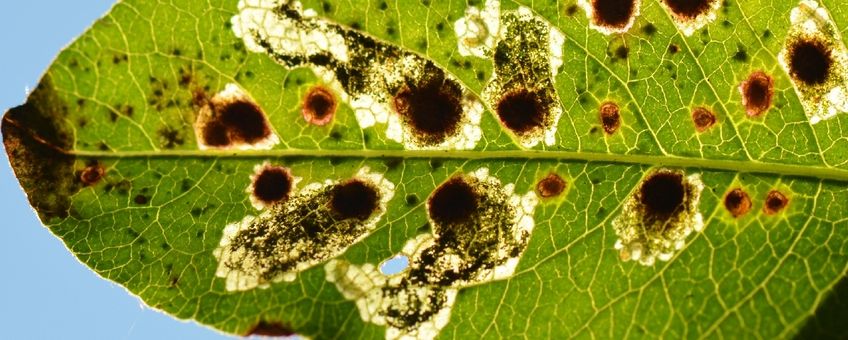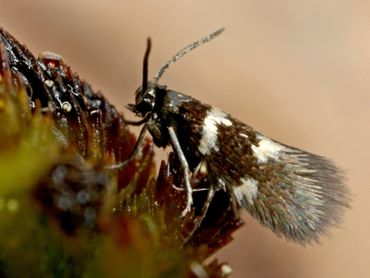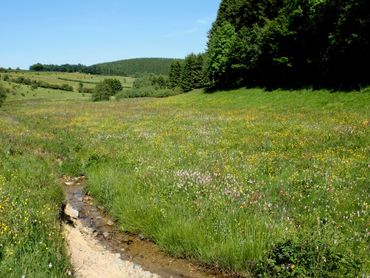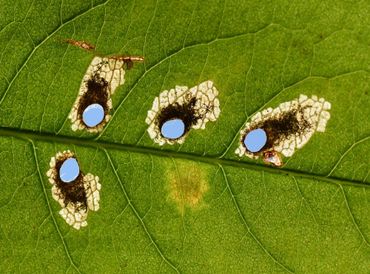
The rare leafmining moth Antispilina ludwigi found in new countries
Dutch Butterfly Conservation, Naturalis Biodiversity Center Antispilina ludwigi was previously only known from a few localities in Germany, Poland, the Czech republic and Lithuania. After the entomologist Erik van Nieukerken discovered the conspicuous leafmines during a hike in the Massif Centrale in France in 2009, he, Steve Wullaert and Rudolf Bryner organised a focussed search for the species in the summer of 2017 respectively in France (Auvergne), Belgium (Ardennes) and Switzerland (Jura and Alps) in sites where snake-root is abundant. To their surprise they were all successful and discovered the leafmines in many sites, sites where the violet copper also occurs. Even though several researchers studying vegetation and butterflies visit these sites regularly, the conspicuous leafmines of Antispilina had never been reported before. The caterpillars can be found from late June to August, a few maybe until September. The very small reared moths (forewing circa two to two and a half millimeter long) emerged the next spring. Only once we observed a moth in nature, in May. In a just published paper in the journal Nota Lepidopterologica the species is described in detail, with information about its life history and distribution.
Antispilina ludwigi was previously only known from a few localities in Germany, Poland, the Czech republic and Lithuania. After the entomologist Erik van Nieukerken discovered the conspicuous leafmines during a hike in the Massif Centrale in France in 2009, he, Steve Wullaert and Rudolf Bryner organised a focussed search for the species in the summer of 2017 respectively in France (Auvergne), Belgium (Ardennes) and Switzerland (Jura and Alps) in sites where snake-root is abundant. To their surprise they were all successful and discovered the leafmines in many sites, sites where the violet copper also occurs. Even though several researchers studying vegetation and butterflies visit these sites regularly, the conspicuous leafmines of Antispilina had never been reported before. The caterpillars can be found from late June to August, a few maybe until September. The very small reared moths (forewing circa two to two and a half millimeter long) emerged the next spring. Only once we observed a moth in nature, in May. In a just published paper in the journal Nota Lepidopterologica the species is described in detail, with information about its life history and distribution.

The leafmine can be easily recognised because of the red brownish spot at the start. From this spot, the larva cuts a case in which it walks away to find a pupation site. The resulting hole in the leaf is characteristic for the vacated leafmine. As this species occurs in a special habitat, well developed sites of snake-root in nutrient poor grasslands, heathland or bogs, the authors assume that it is a vulnerable species. Just like the butterflies that share its habitat and hostplant. The authors propose that naturalists who monitor the butterflies of snake-root also check the plants for the conspicuous leafmines of Antispilina. In this way new localities can be found. The occurrence of this species is an extra argument for conservation of its special habitat. In this way it would also be possible to break down the existing barrier between researchers of butterflies and smaller moths. There are more cases of rare butterflies sharing a hostplant with equally rare small moths. Contact has already been made with researchers who study the blue copper in the Eifel region, in order to look for Antispilina ludwigi over there.
More information
- Article Nota Lepidopterologica
- GBIF occurrence dataset
- More info on Lepiforum.de
- More info on Belgische bladmineerders
Text: Erik J. van Nieukerken, Naturalis Biodiversity Center
Photo’s: Rudolf Bryner; Steve Wullaert; Alexander Rauw

